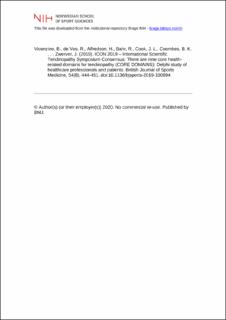| dc.description.abstract | Background: The absence of any agreed-upon tendon health-related domains hampers advances in clinical tendinopathy research. This void means that researchers report a very wide range of outcome measures inconsistently. As a result, substantial synthesis/meta-analysis of tendon research findings is almost futile despite researchers publishing busily. We aimed to determine options for, and then define, core health-related domains for tendinopathy. Methods: We conducted a Delphi study of healthcare professionals (HCP) and patients in a three-stage process. In stage 1, we extracted candidate domains from clinical trial reports and developed an online survey. Survey items took the form: ‘The ‘candidate domain’ is important enough to be included as a core health-related domain of tendinopathy’; response options were: agree, disagree, or unsure. In stage 2, we administered the online survey and reported the findings. Stage 3 consisted of discussions of the findings of the survey at the ICON (International Scientific Tendinopathy Symposium Consensus) meeting. We set 70% participant agreement as the level required for a domain to be considered ‘core’; similarly, 70% agreement was required for a domain to be relegated to ‘not core’ (see Results next). Results: Twenty-eight HCP (92% of whom had >10 years of tendinopathy experience, 71% consulted >10 cases per month) and 32 patients completed the online survey. Fifteen HCP and two patients attended the consensus meeting. Of an original set of 24 candidate domains, the ICON group deemed nine domains to be core. These were: (1) patient rating of condition, (2) participation in life activities (day to day, work, sport), (3) pain on activity/loading, (4) function, (5) psychological factors, (6) physical function capacity, (7) disability, (8) quality of life and (9) pain over a specified time. Two of these (2, 6) were an amalgamation of five candidate domains. We agreed that seven other candidate domains were not core domains: range of motion, pain on clinician applied test, clinical examination, palpation, drop out, sensory modality pain and pain without other specification. We were undecided on the other five candidate domains of physical activity, structure, medication use, adverse effects and economic impact. Conclusion: Nine core domains for tendon research should guide reporting of outcomes in clinical trials. Further research should determine the best outcome measures for each specific tendinopathy (ie, core outcome sets). | en_US |
